The shortage of certified welders is a constant concern for the future of the industry, yet too few organizations have created successful programs that introduce new blood to the workforce. In the heart of racing country, however, one company has found a way to engage new welders by reaching out and teaching them in ways that traditional schools have not.
Palmetto Motorsports, a Myrtle Beach, South Carolina-based racing company, created the Palmetto Advancement for Learning Motorsports (PALM) program. PALM, a 501 (c) 3 non-profit company, takes at-risk youth and non-traditional learners of all ages and molds them into skilled welders while giving them the resources to become self-reliant and successful individuals. Entering its third year of operation, PALM has graduated almost 100 skilled laborers. It aims to populate body shops, fabricators, manufacturers and contractors with new workers as it expands its curriculum offering interesting subject matter like that of it’s new motorcycle program. Students focus on designing and constructing bikes from the ground up, learning the mechanics, fabrication skills and most importantly, how to work with each other.
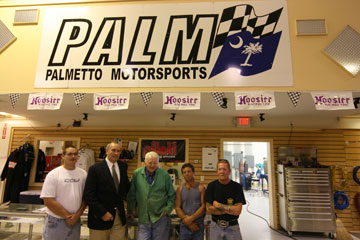 |
|
Faculty and staff of the PALM program pose outside the classroom in Myrtle Beach, South Carolina.
|
Incentive-Based Education Builds Pride, Work Ethic
Mack Sarvis and Ron Miller started the PALM program in 2005 to provide “comprehensive competency-based learning environments” to those in South Carolina’s Waccamaw and Grand Strand regions. Warren Murphy, a certified welding educator (CWE), certified welding inspector (CWI) and former district manager with Miller Electric Mfg. Co., joined PALM in 2006. Together they built a school that teaches each student the intricacies of welding by incorporating lessons into actual motorsports projects.
“We work with at-risk youths,” explains Sarvis. “Students who are having trouble and don’t respond to traditional educational methods. Some have had trouble with the law and they’re here because the judge told them to come here or go to juvenile detention. We also require our students to get their GED and we have a general education teacher on site to work them through that program. Then we have an agreement with Greenville Technical College. If these kids want to go on, they can take five courses with us and get college credit for them.”
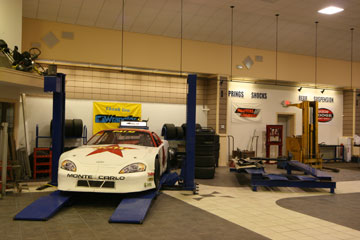 |
|
The PALM program thrives in a non-traditional classroom built around motorsports that allow students to work on projects that interest them.
|
In addition to high school-age students, PALM also takes in dislocated workers and adults who want to learn a new trade and enter the workforce as a skilled tradesperson. Unlike traditional schools, PALM doesn’t charge tuition. Funding through the Waccamaw Regional Council of Governments and the Waccamaw Workforce Investment Board allows the program to offer all of these services for free and offer added incentives to students.
“It’s like a business,” explains Sarvis. “Students get paid for attending class. If students without a GED complete their GED, they get a little boost in salary. And when they get certified through Warren, they obtain four levels GMAW,Gas Metal Arc Welding for Steel and Aluminum, GTAW Gas Tungeston Arc Welding for Steel and Aluminum of welding certification through AWS.”
Sarvis says the real world aspect of PALM differentiates from other institutions. “I have found that we can use motorsports to teach everything that the public school teaches. We’re also different from schools where students sit in a booth and just weld on metal coupons. When students actually see their welding projects in action on the track, it gives their creation special meaning.”
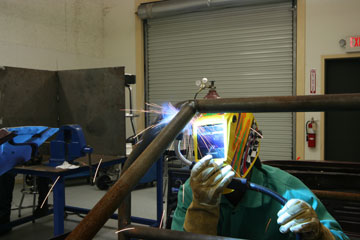 |
| PALM student Anthony Richardson welds on the frame of a 1980s era Ford Mustang. |
Welding Certification Teaches Skills to Advance
The PALM program teaches its students MIG, TIG and Stick welding, as well as plasma cutting. PALM has three areas of curriculum (welding, motorsports and paint and body). Welding serves as a starting point to ensure that students learn skills that can land them a job in the motorsports, automotive, aviation or other welding-related industries. Palm courses last 12-weeks, and students must meet Murphy’s high standards before they pass the welding segment. Murphy’s teaching even extends beyond class hours, as he mentors the men and women in the program.
“I tell students to come and see me if they want to be more proficient, if they want to brush up on or improve their skills before a job interview,” explains Murphy.
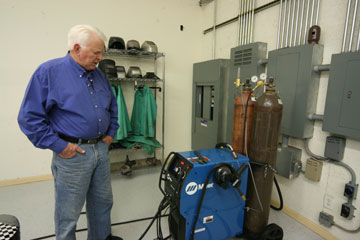 |
|
Warren Murphy inspects the newest addition to the PALM welding fleet: the Millermatic® 350P.
|
PALM’s students are AWS certified to AWS code 9.1 sheet metal when they finish their classes, but Murphy’s involvement doesn’t end there. His connections throughout the welding industry span the country and have been solidified with more than 45 years of experience. He uses those connections and his wealth of knowledge to help place students in jobs that suit their skill and interest, whether it’s at a body shop in Myrtle Beach or a helicopter plant in Philadelphia.
“He knows everyone in the industry, and they respect his opinion,” explains Sarvis. “We have employers come into the school and look at the students and he’ll tell them just how good they are. And he’ll actually go on the job with them on their first day to make sure that the student and employer are expecting the same things from each other.”
That kind of attention to quality and nurturing turns students into skilled tradespeople¾people who may not have otherwise found a career in the welding industry. Lenny Herrington and Todd Mosseller are two of Murphy’s students who came to the program from other careers, graduated and have now moved on to steady work as skilled welders.
“I went to college for three years and learned more from Warren in two weeks than I probably learned in six months of college,” says Mosseller, who now works as a welder for Wrought Iron Guys, LLC of Myrtle Beach.
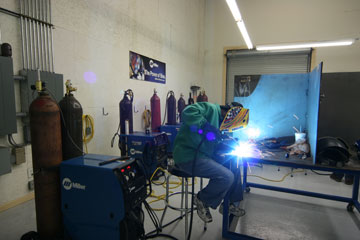 |
|
PALM student Velma Suggs practices using the Millermatic 350P.
|
“Warren emphasizes doing your own projects so that you can learn on your own,” adds Herrington, who now works as a welder for Mason’s Goodyear Tire in Myrtle Beach. “I built a ladder rack for my truck (in class). He told me to ‘think about it and make it yourself. I’ll help you, just give me your idea and I’ll show you the way.’ So you come through this class and you learn (the curriculum), but you also get into something you want to build.”
Racing into the Real World
That kind of hands-on learning is exactly what Miller and Sarvis had in mind when they started the school.
“Not all students learn the same,” says Miller. “If I brought most of our students in here and started explaining a roll center to them, they wouldn’t care about it. But if I drove a race car in here and started making a lot of noise and I said we’re going to make a roll center, then it has a whole different meaning.”
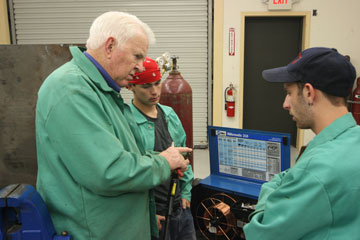 |
|
Warren Murphy discusses burnback with PALM students.
|
The innate attraction to motorsports is what brings many of the students to the PALM program and keeps them motivated to complete it. As Herrington described, once students learn the basics of welding, they can go through to the other courses and continue to work on real cars that will compete on the track. Some students drive the finished product while others are content to work in the pit or on another car at the shop. While many may not continue to work in motorsports, the skills and lessons they’ve learned at PALM will carry them through to whatever form of metalworking they go into.
It’s this kind of application-based, competency-driven curriculum that inspires many to succeed in an industry hungry for new, skilled labor.
 |
|
A PALM student practices with the Syncrowave 200.
|
Next, Sarvis plans to expand the program and introduce a whole new generation of welders to pride and joy of working with motorsports.
“You can weld on a car and say ‘hey, I did that’,” says Sarvis. “’I helped set that car up. I helped put that roll cage on. I welded the body panels on.’ It makes all the difference in the world to a student.”
Palm Program Bleeds Miller Blue
The PALM teaching lab that Sarvis, Miller and Murphy built is noticeably Blue. While Murphy spent a good portion of his career as a Miller district manager, he has also traveled and worked for other welding manufacturers. He has taught and worked with nearly every brand of welding equipment and keeps coming back to Miller.
“That’s not because I worked for Miller,” Murphy is quick to point out. “These are fantastic machines.”
PALM uses Syncrowave® 180s to teach conventional TIG welding and Syncrowave 200s for conventional and pulsed TIG welding. The Syncrowave 200 provides 5- to 200-amp output power (150 amps at 40-percent duty cycle), enough to weld 1/4-in. aluminum with AC TIG. The extended amperage range provides the power to weld thicker material, and with a 5-amp low end, it improves control on thin material.
With the Syncrowave 200’s built-in pulser, operators can easily attain professional-looking weld beads. Pulsing reduces heat input by allowing the puddle to cool between pulses, minimizing burn-through and warping. A single adjustment knob controls the pulse rate (or frequency) from 1 to 15 pulses per second.
Using low frequencies, operators can create a ‘stacked-dimes’ look by timing the addition of the filler rod to the frequency of the pulse. On DC applications when not using a filler rod, operators can get a very distinct ripple pattern by setting the pulse rate higher and coordinating it with travel speed.
PALM also has six Millermatic® 210s and a few 115-V Millermatics for teaching MIG welding on steel. The newest addition to the PALM learning fleet is Murphy’s favorite: The Millermatic 350P MIG welding power source with built-in pulsed MIG programs.
Murphy has matched the Millermatic 350P with a Spoolmate™ gun and uses the setup to teach conventional and pulsed MIG, and he considers it as a solution to improve fusion, penetration and reduce cold lap when welding roll cages made from DOM (drawn over mandrel) steel tubing.
Due to the wall thickness of tubing used in motorsports applications, generally .093 to .125, heat input must be controlled to prevent burn through. With pulsed MIG, the current pulses between a high peak and a low background current. The peak pulse provides good fusion, while the background current gives the weld puddle a chance to cool slightly¾and Murphy thinks this could be the ticket for improving quality and travel speed on roll cages.
“This is one of the best pulsed MIG machines I’ve ever seen,” claims Murphy, who has worked with pulsing systems from Miller. “It passes every test I’ve given it for response time and ease of use. It’s a super welding machine and is very operator-friendly. It’s the best pulsing machine Miller has ever put on the market for the money.”
After Murphy perfects welding DOM steel tubing, he plans to test pulsed MIG on chrome-moly tubing—previously the strict domain of TIG welders.